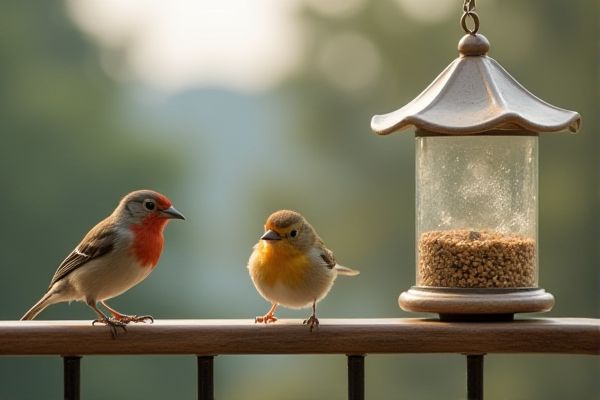
Balcony bird feeders are ideal for small outdoor spaces and allow you to enjoy birdwatching up close without disturbing the environment, while floor bird feeders accommodate a wider variety of bird species and are more suitable for larger garden areas. Discover which feeder suits Your space and attracts the best feathered visitors by reading the rest of the article.
Table of Comparison
| Feature | Balcony Bird Feeder | Floor Bird Feeder |
|---|---|---|
| Placement | Mounted on balcony rails or windows | Placed directly on ground or stand |
| Bird Access | Attracts smaller, perching birds | Accessible to ground-feeding species |
| Safety | Elevated, safer from predators | More vulnerable to cats and other predators |
| Space Requirement | Ideal for limited balcony space | Requires open ground area |
| Installation | Easy, no ground disturbance | Requires stable ground placement |
| Maintenance | Easier to clean and refill | May need regular cleaning due to dirt |
| Bird Variety | Small songbirds, finches, sparrows | Ground feeders like doves, juncos |
| Weather Protection | Often more sheltered from rain | Exposed to elements, may need cover |
| Overall Best For | Urban dwellers with limited outdoor space | Garden owners with open space |
Introduction to Balcony and Floor Bird Feeders
Balcony bird feeders are designed to be compact and space-saving, perfect for urban settings where outdoor space is limited. Floor bird feeders offer larger capacity and attract a wider variety of bird species due to their accessible placement on the ground. Your choice depends on available space, desired bird types, and ease of maintenance.
Key Differences Between Balcony and Floor Bird Feeders
Balcony bird feeders are designed for compact spaces, attaching securely to railings to attract small birds without occupying ground area, while floor bird feeders rest on or near the ground, accommodating larger bird species and seeds. Balcony feeders often offer easy visibility and maintenance for urban or apartment dwellers, whereas floor feeders provide a natural feeding environment for ground-feeding birds like sparrows and juncos. Your choice between these feeders depends on available space, bird varieties in your area, and ease of access for refilling and cleaning.
Advantages of Balcony Bird Feeders
Balcony bird feeders offer the advantage of space efficiency, making them ideal for urban dwellers with limited outdoor areas. Their elevated placement reduces the risk of ground predators, ensuring safer feeding for birds. You can enjoy close-up birdwatching from your window while minimizing mess and attracting a diverse range of bird species suited to smaller, more contained environments.
Benefits of Floor Bird Feeders
Floor bird feeders attract a wider variety of bird species, including ground-feeders like doves, sparrows, and juncos, enriching backyard biodiversity. They provide easier access for larger birds that struggle with smaller, elevated feeders, enhancing feeding opportunities. Positioned naturally, floor feeders require less installation effort and are ideal for gardens with ample open ground space, promoting natural foraging behavior.
Space Considerations for Bird Feeder Placement
Balcony bird feeders are ideal for limited outdoor spaces, optimizing vertical areas without occupying valuable floor space, making them perfect for apartments or small patios. Floor bird feeders require more ground area but attract a wider variety of birds that prefer feeding closer to the ground, enhancing birdwatching opportunities in larger yards. Your choice depends on space availability and the types of birds you wish to attract, balancing convenience with ecological preferences.
Bird Species Attracted by Each Feeder Type
Balcony bird feeders commonly attract smaller bird species such as finches, chickadees, and sparrows due to their elevated placement and limited space. Floor bird feeders tend to draw ground-feeding birds like doves, juncos, and mourning doves, which prefer easy access to seeds on flat surfaces. Understanding the preferences of local bird species can optimize feeder placement to increase visitation and birdwatching enjoyment.
Safety and Accessibility for Birds
Balcony bird feeders offer enhanced safety by keeping birds elevated and away from ground predators such as cats and raccoons, reducing risk of harm. Floor bird feeders provide easier accessibility for ground-feeding bird species but may expose them to increased danger from predators and harsh weather conditions. Choosing a balcony feeder can better protect your feathered visitors while still accommodating various bird types depending on your local wildlife.
Maintenance and Cleaning Comparison
Balcony bird feeders typically require less maintenance and are easier to clean because they are smaller, more accessible, and often designed with detachable components for quick washing. Floor bird feeders, while accommodating larger bird species and more seed capacity, can accumulate dirt, debris, and droppings more quickly, demanding more frequent and thorough cleaning to prevent mold and pest issues. Regular sanitation of both types is essential to maintain bird health and ensure feeder longevity.
Impact on Local Wildlife and Environment
Balcony bird feeders offer a compact feeding solution that minimizes habitat disturbance and reduces the risk of attracting larger, potentially invasive animals compared to floor bird feeders. Floor feeders can support a wider variety of species but may increase the chance of predation and the spread of disease among birds due to ground contamination. Both types influence local wildlife differently, making it important to select a feeder based on specific environmental conditions and bird populations.
Choosing the Right Feeder for Your Home
Selecting the ideal bird feeder depends on your living space and bird-watching preferences. Balcony bird feeders are perfect for small outdoor areas, providing close-up views while saving ground space, whereas floor bird feeders cater to larger gardens and attract a wider variety of bird species. Consider your environment and space availability to ensure your feeder supports the local bird population and enhances your outdoor experience.
 homyna.com
homyna.com